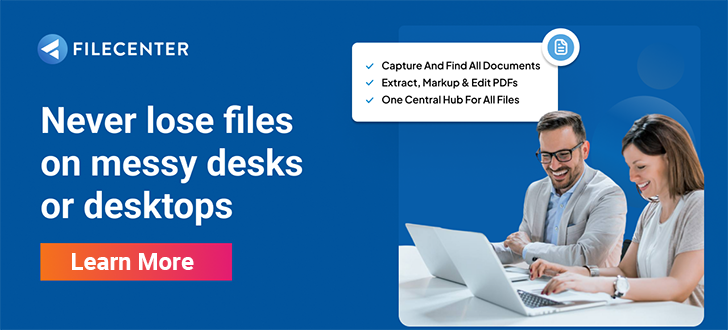Document Management vs Content Management: Understanding the 5 Key Differences

Want to improve how you manage information?
Then it’s important to learn key business document management and content management differences.
Otherwise, you may fail to optimize your workflow accordingly or choose the right technologies, resulting in inefficiencies and below-par business impacts.
A PwC survey discovered 60% of technology investments don’t deliver expected results. This is partly due to poor alignment with business goals.
If you’re keen to invest in the right strategies and maximize the impact of digital technologies, I’ve rounded up some extremely important document management vs content management differences for us to explore.
These will help you understand what types of content are ideal for each strategy, so you can choose a practice that best aligns with your small business goals and needs.
If you’re interested in improving information management, check out this article I wrote about key document management statistics reshaping the industry.
In this article, we’ll get into the document management vs content management debate, and unlock key differences to help you improve technology investment decisions.
Let’s get started.
What is document management?
Document management improves file organization.
It generally refers to the practice of tracking, organizing and securing various electronic or physical documents. What’s more, it may involve the scanning and digitization of paperwork to make them searchable and easy to store.
With a proper document management strategy, you can reduce paper usage, and make the organization & storage of sensitive files more efficient and effective.
But in order for that to happen, you need a great document management software (DMS) to help you take control of your business documents and boost productivity.
So consider our software and start your free FileCenter trial today. It can help you revolutionize document management with real-time access to files, within a scalable on-premise or cloud-based solution that scales well with your business.
From speeding up document creation to automating manual tasks like naming and approvals, our software turbocharges productivity and lowers business risks.
What is content management?
So what is content management & why does it matter?
Content management is the practice of overseeing the creation, publication and even archival of website content like blog posts, web pages and even various digital marketing assets.
Given the vast amount of information your business may handle, content management is a vital practice that makes it easier to find and update content.
In addition, by leveraging no-code website management tools, it enables you to quickly create and publish content without needing to have advanced technical skills.
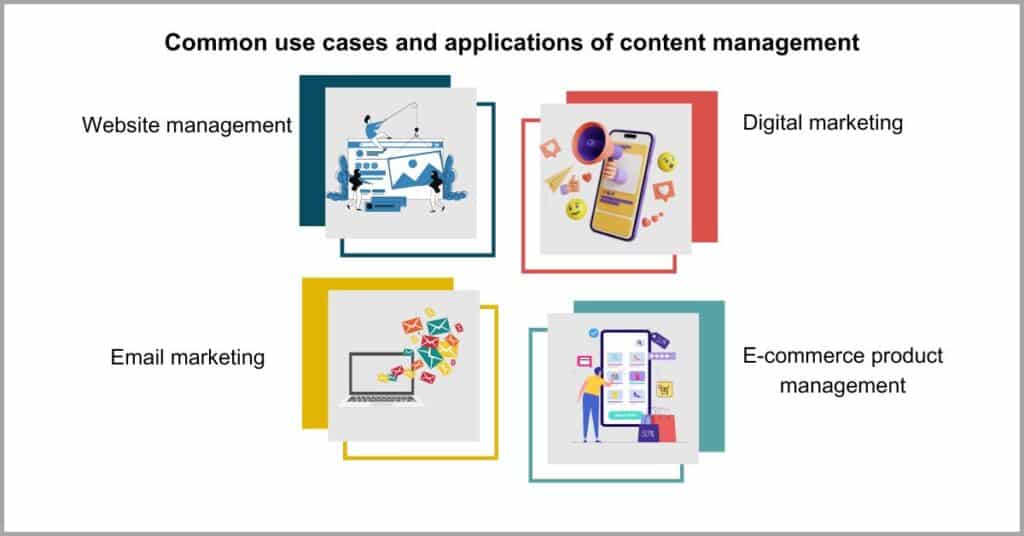
It’s a practice to help you improve digital asset management, by ensuring uniform messaging, formatting and branding across all your digital content and channels.
This covers a variety of platforms which may include your website, social media, email marketing platforms and other business applications that host your digital assets.
Crucially, content management is more prevalent with use cases such as digital marketing, blogging and website management, representing important document management vs content management differences particularly in terms of purpose.
Key differences between document management and content management
1. Primary purpose
What is the goal of document management?
The primary focus of document management is usually to digitize paper records into electronic documents, improve electronic file organization, and generally to remove inefficiencies particularly when it comes to managing business documents.
Without proper document management to enable easy access to documents, you may struggle to find information or even share files and collaborate.
A study by Equidox unearthed that 72% of employees struggle to go about their work because of file accessibility issues. These challenges are hiding information from them, resulting in massive delays and frustrations as well as very huge productivity dips.
The primary objective of document management is to solve these issues to make documents easier to find, organize and generally work with.
On the other hand, content management is typically focused on managing web content and digital assets, particularly for websites and online platforms. This marks a very key document management vs content management difference to take note of.
That said, if you’re looking to improve access to business documents, save time and heighten your productivity, you should consider our document management tool.
So click here to begin your free FileCenter trial to use our software to manage files, records, contracts and many other small business documents more efficiently.
With our platform, you’ll get access to bulk digitization features, which enable you to go paperless and achieve huge paper savings. You’ll also get metadata tagging and powerful search capabilities to decrease document retrieval times for your business.
2. Type of information
There are also stark differences in terms of content.
When it comes to content management, for example, it usually covers a broader range of digital content. This includes both structured/unstructured data like web pages, multimedia files, website articles and, sometimes, even digital business assets.
By centralizing all your content and digital assets, content management helps you to minimize the time and effort required to manage these items.
Unfortunately, at least 48% of businesses waste too much time and resources managing their digital assets. These challenges largely stem from the lack of a structured and systematic way of organizing and managing them.
This is where content management saves the day, empowering your small business to manage assets and structured and unstructured data more efficiently.
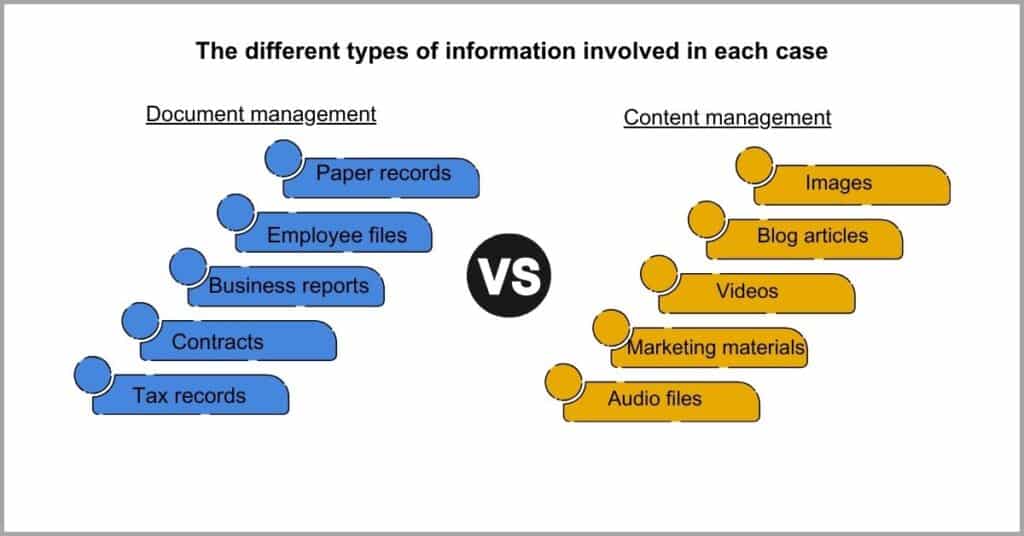
So what about document management?
While content management involves very diverse content types, which includes text, images, videos and even interactive media, document management largely deals with text-based files such as Spreadsheets, Word Files, and PDFs, for example.
That being said, I’ve noticed some PDF to OCR document management software can also handle image-based files as well. This is due to robust optical character recognition technologies, which enables these tools to recognize text in scanned images.
Document management may also involve managing email documentation to enhance organization, whereas content management has very little focus on these types of files.
Another key document management vs content management difference is that document management may also involve the long-term archival of business records, including contracts, employment documentation and more, for compliance purposes.
3. Technologies involved
So what tools does content management use?
This practice typically ropes in a dedicated content management system or CMS. It typically comes with themes and templates for website design customization, while you can even add plugins and extensions to extend functionalities.
Additionally, a CMS may also have website analytics for personalizing web experiences, which is key to helping you get around lead conversion challenges.
It’s interesting to note that 49% of businesses invested in a content management system primarily to improve customer personalization, as per a Winterberry Study. Other top motivations were enhancing SEO & creating consistent omnichannel experiences.
So it’s safe for us to conclude that a content management system is largely geared for managing website content and visitor experiences.
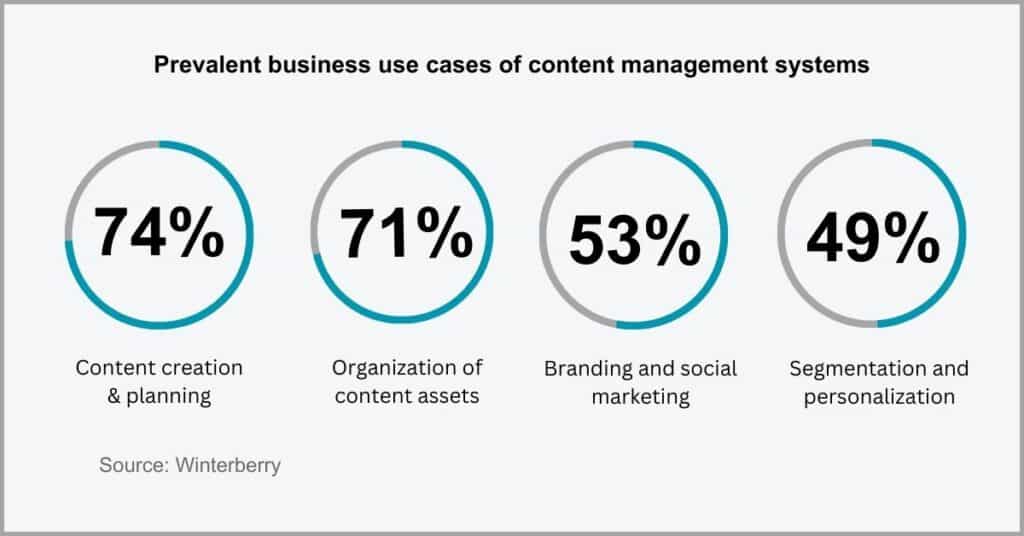
Meanwhile, when it comes to business document management, you’ll usually turn to document management software. The tools typically have features which are purpose built for effective document digitization, version control, and enabling collaboration.
Some unique features which you may find in a DMS include electronic signatures for improving approvals and automated record retention for enhancing compliance.
Conversely, your content management system may have features built toward website management, marketing, e-commerce and supporting blogging, marking another key document management vs content management distinction.
The end-users of these tools are also typically different.
While a document management software is used by business and internal teams for secure document storage, a CMS is usually the go to for web developers, content creators and marketers, who use it to manage digital experiences for web visitors.
4. Storage and organization
Both also rely on different storage mechanisms.
For example, content management typically involves the use of databases and even content repositories, which usually have tagging systems and taxonomies to help you classify content you’ve published for better organization.
With the use of databases, your small business may face the increased risk of vendor lock-in, which makes it challenging to switch your CMS provider.
A survey by Statista revealed that 50% of businesses are concerned about vendor lock in, which is why they prioritize no vendor-lock in when choosing cloud or CMS vendors. It’s an important criteria to also consider so that you’re not tied down to one option.
These are issues that mostly arise because a content management system is usually database dependent.
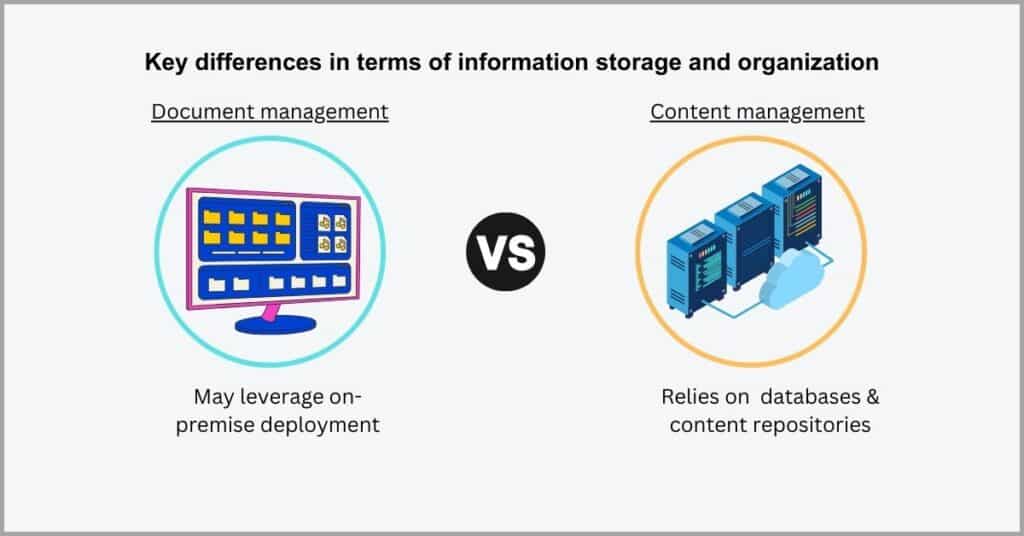
So does a DMS solution rely on a database?
Well, the truth is that some cloud-document management systems use a database repository, however, a great number of them rely on a simple filing system and folders to store and organize your information within your system.
This differentiates document management vs content management systems, especially when it comes to how these platforms store and organize your information.
If you’re keen to avoid vendor lock-in, try our FileCenter software for free today. You’ll get a simple Windows-based filing system, which keeps your files within your own computer, ensuring full control and authority over your data.
Moreover, our software also integrates with popular cloud services, enabling you to leverage the power of the cloud to improve remote access to your documents.
5. Version control
So what is version control exactly?
Version control is the practice of tracking and managing changes made to a document over time. It may involve the sequential numbering of updated versions with unique identifiers, complete with history tracking to let you know who modified what and when.
Without proper version control, your small business can easily experience cases of data loss, particularly when multiple users are editing a document.
The situation is quite dire with over 83% of workers losing time daily because of document versioning challenges, according to a study by M-Files. When different file versions play hide and seek, you can easily work with outdated information.
It’s partly because of this that document management becomes necessary for enforcing best practices for more effective version control.
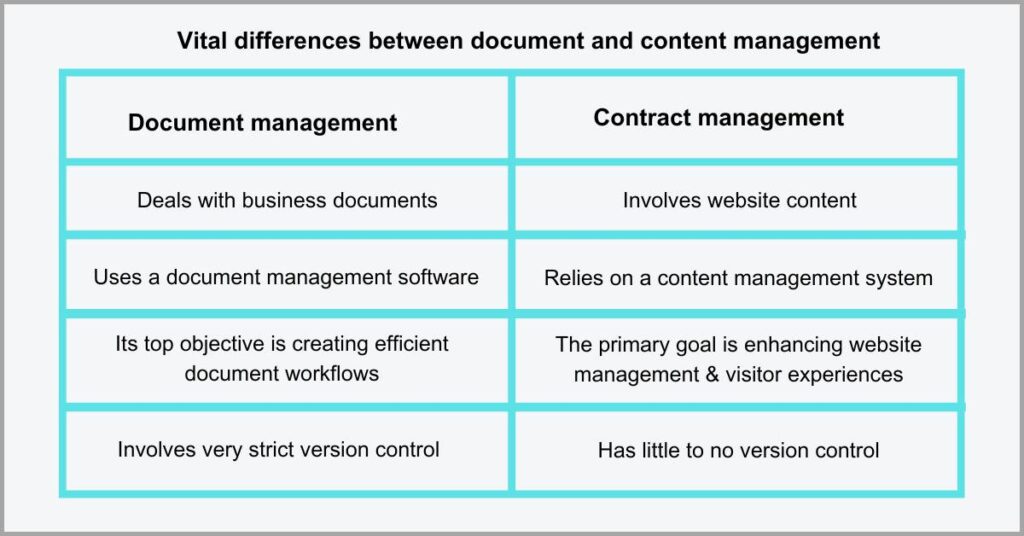
That being said, cloud-based document management has a very strong focus on version control in order to streamline teamwork. It helps your small business to prevent editing conflicts and the risk of working on outdated files.
Content management, meanwhile, has little focus on version control.
In our document management vs content management debate, this is another very important difference, although this is not to say that content management systems don’t support collaboration in some way.
Far from it, you can use these tools to set up multi-user content creation and editorial workflows to streamline website publishing and facilitate efficient teamwork.
While it may provide some level of versioning, it has less advanced features in this aspect, with content management more geared toward publishing and content updates.
How to decide if you need a DMS or a CMS
a) Consider your primary needs
You first need to figure out your most vital needs.
This will largely depend on the type of content that you often handle. For instance, if you need to be able to manage Word documents, spreadsheets, PDFs and business files more efficiently, I recommend a DMS.
With a great document management software, you can reduce the time spent on iterative document work to increase productivity for your small business.
A survey by Backer McKenzie showed 79% of businesses have either adopted digital document solutions or plan to do so soon. The primary motivation is to create more direct labor time for revenue-driving tasks.

Want a better way to manage website content?
In this case, you should go with a content management system, which is geared toward handling website content and helping you improve website management at large.
It’s worth noting that some of the best enterprise document management systems also double up as content management solutions so some features may overlap.
That being said, the point is that if you need an efficient tool for managing business documents, I suggest that you invest in a proven DMS. If you want to manage your website better and improve SEO, then you may be best served by a CMS platform.
b) Evaluate deployment preferences
CMS solutions are typically web-based.
While this can be a good thing because it alleviates the need to install any software on your computer and also offers remote accessibility to content, it also means that you’re shackled to the availability of an internet connection or cloud services.
In case you experience an internet or cloud outage, you may lose access to critical business files, resulting in serious downtime for your small business.
A study by Uptime institute found that 60% of cloud outages result in over $100,000 losses for businesses. These stemmed from lost work time and lost customers, among other missed business opportunities.
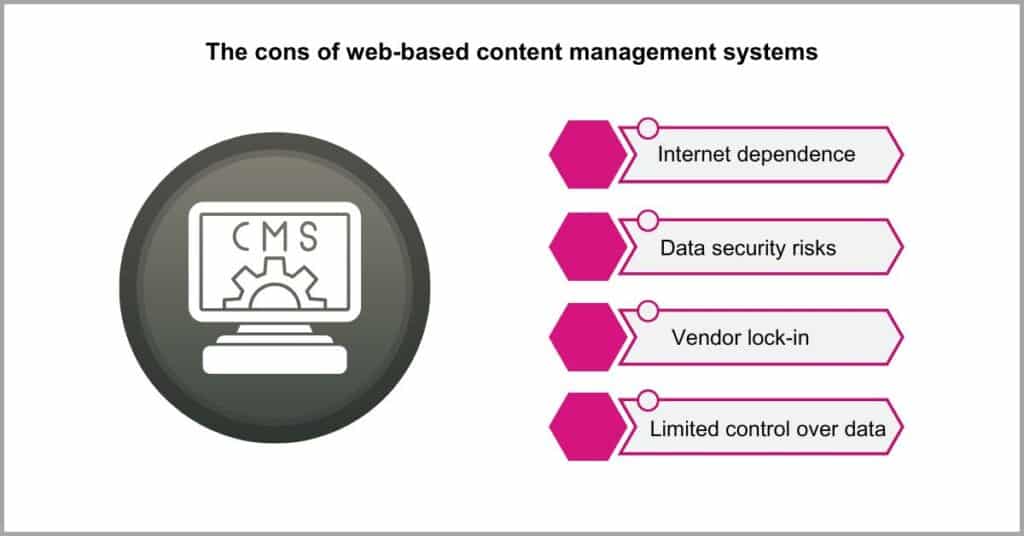
Are document management systems web-based?
It’s true that some cloud-based document management software are web-based, but others like our software, FileCenter, also support on-premise deployment, giving you the option to choose a hosting model that aligns with your preferences and objectives.
This is yet another key document management vs content management difference, because CMS platforms are usually only web-based.
The great thing with being able to deploy your DMS on-premise is that you completely do away with third-party cloud providers. So these are tools I recommend if you want to reduce your external security risks for better compliance or internal policy adherence.
c) Assess compliance & security
Do you operate in a highly regulated industry?
If that’s the case, your small business may have to deal with very strict data protection regulations. This is in addition to possible record retention rules that may mandate you to keep employee files and other key business information for stipulated periods.
So if you have strict compliance and security requirements, you should consider a document management software, which reduces non-compliance risks.
A survey by NAVEX brought to light that at least 50% of organizations faced at least one compliance issue between 2021 and 2024. The lion’s share of these events largely centered around poor data protection.
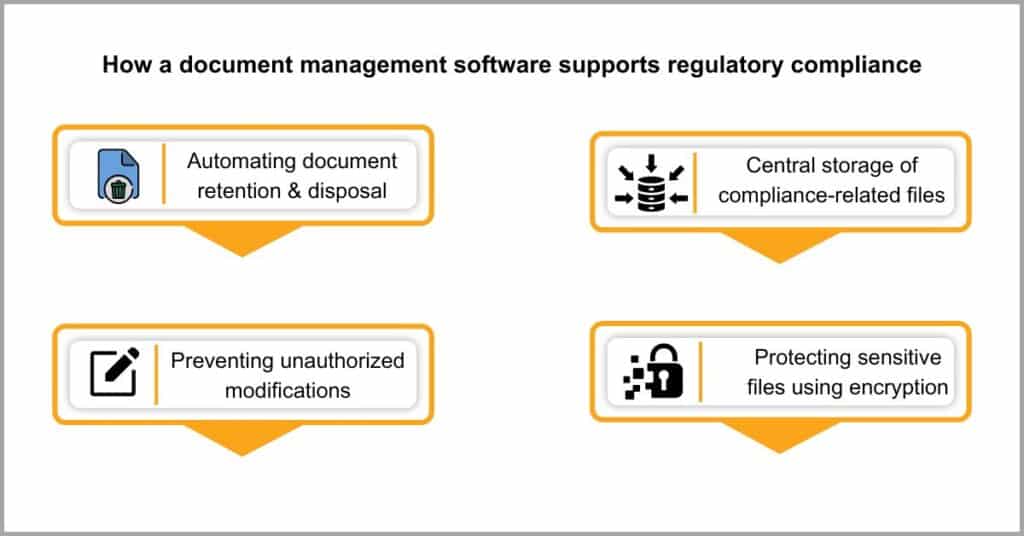
That said, if you have data protection needs and compliance obligations, your small business may need a top document management software for better data security.
These offer more advanced access control and user permission management features, which enable you to prevent unauthorized document actions. You may also get detailed audit trails to improve transparency and compliance tracking.
While your content management system may offer some data protection features, it typically doesn’t offer advanced audit trails, encryption and other important data security capabilities necessary for compliance.
It’s a technology that’s typically great for managing public or marketing content, and not really for improving document security and helping you with your compliance needs.
Conclusion
Your business may generate vast information.
This includes everything from contracts and invoices to marketing materials & blog posts.
With a poor understanding of document management and content management, you may not choose the right strategy for extracting maximum value from data.
A study by One Data showed that 59% of businesses struggle to derive value from their data. The biggest contributor is poor information management from not having the right tools and strategies in place.
Now that we’ve covered some important document management vs content management differences, you can choose a great strategy. If you’ve determined you need a top DMS, consider our proven software.
So why not start your free FileCenter trial today? You’ll get access to important capabilities that streamline your document workflow.
Whether you’re looking to manage corporate records or small business invoices more efficiently, our platform has the features to help you improve efficiency and productivity.

